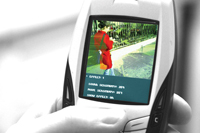March 27, 2007
Vague Terrain

Locative
vague terrain: locative: Why is location interesting? Several years ago, I inherited a broken television set from my grandmother. I had little use for a TV that displayed everything in shades of green, and so it stayed in the attic. It was only when I was later preparing to move that I decided to turn it on. What I found when I turned the dial to the highest UHF channel was that the TV picked up what sounded like eight simultaneous cordless phone conversations. I could barely decipher anything in the cacophony, but it did make me wonder who these people were, where they were standing as they were speaking these words, if these conversations were passing through me, and if they knew I was listening.
I have to thank both Greg J. Smith and Neil Wiernik for inviting me to be the first guest editor. Neil and Greg have both done an enormous amount of work on the journal since its inception. Their efforts are creating an amazing archive of the state of the arts during this nascent period of technological curiosity and exploration.
Even though the digital age has been around long enough that we possess theorists' interpretations of its implications, it's almost as if artists are only just wending their way through these new ways of communicating, and it's this excitement of exploration that's palpable in the art work. Projects that begin with an exclamation of "oh, neat!" quickly give birth to perspectives that come to reshape our understanding.
When I was first asked to edit the journal, it was to be on the subject of mobile technology due to my experience with projects such as the Warbike, an artwork that creates music from WiFi networks through which a cyclist rides. But to consider mobile technology is not to marvel at the ability to watch TV on one's cell phone—merely shifting content created for one medium to another—it is to consider the implications of our new-found ability to take it with you. Watching TV on the subway is not the same thing as watching TV in your home.
The latest PDA and cell phone developments are easy targets for theorising about mobile technology, but a device as simple as Sony's Walkman in 1979 drastically altered the ways in which people communicate in public. Although it innocently allowed you to take your music out of the home, it actually created an entirely new set of communicative gestures using headphones: disregard for others by playing music too loudly, taking headphones off to signal an openness to engage verbally, putting headphones on to avoid contact in public.
What changes when we take it with us? The parameter is space, or place. The term locative, in many ways, gives one the impression of a device with some artificial intelligence that allows the little thing—if I'm forgiven to personify our cute gadgets—to know something about the space in which it's situated or moving through. Of course, artificial intelligence, especially confined to the current power of mobile processors, is nowhere near smart enough to truly understand anything about space. It cannot contextualise the same way that you or I would if placed in a foreign space. What it does do is give us information based on the space according to the parameters and design that we've set up for it. It doesn't give us information outside of the media we've chosen, but this still allows for a great amount of surprise and discovery.
The renewed interest in space generated by mobile technologies such as the cell phone, and location-specific technologies such as GPS, has spread to areas beyond the high-tech. People are finding connections between their perceptions of space and those of the Situationists in the twentieth-century, and the wanderings of the Surrealists before them. Communities are forming psychogeography societies to explore their urban surroundings. Civic interest and concern in urban centres is not only healthier than ever before, but gaining momentum.
Several of the projects in this issue deal solely with the radio spectrum and eavesdropping as a means of understanding the human facet of their immediate surroundings. This is a technology that has existed for decades. But the discourse generated from the interest in more sophisticated technologies has allowed us to contextualise the implications of older technologies and our perceptions of space, especially the blurring of public and private spaces.
Each of the projects featured in this issue deal with space in several manners. It's the synthesis of the experiences and understandings created by many focussed projects that allow us to understand not the gadgets' relationship to space, but our own.
The explorations of ssim-el and Sawako's 2.4Ghz Scape examine the invisible layer of communications that passes through public space unbeknownst to us.
The Context Photography project follows a traditional approach to locative technologies: using the technology to help us better understand aspects of the space. Evamaria Trischak's 4816 also touches on this, as well it and and Patricia Rodriguez's cell phone videos explore technology as medium for our conduct: although it provides insight, at the same time it imposes limitations through its structure that may hamper our ability to understand space.
Mobile technology is also an enabler, either helping to create new forms of narrative not previously possible, as with knifeandfork's Hundekopf, or to foster community and civic interest, as discussed in my interview with Île Sans Fil's Michael Lenczner.
Finally, the articles of Marc Tuters and Jeremy Hight question our definitions and understandings of the field of locative technology, its possibilities, and its future.
Thank you very much to all of the contributors who made this issue possible not only through their projects, but also with their co-operation in compiling all of the information. Feel free to send any comments my way to locative [at] vagueterrain [dot] net, and please let the contributors know how their work engaged you.
david mccallum
Posted by jo at March 27, 2007 01:31 PM
